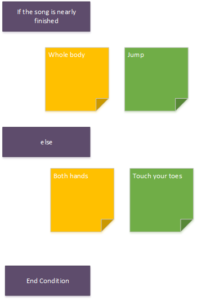Introduction
This a great example of how technical concepts like computational thinking can be developed through creative subjects such as dance.
This activity can be done by a family group (adults you have to dance!) or in small groups within a class environment.
Materials
- pen/pencil
- post-its/sticky notes
- Access to songs with dance routines as part of the lyrics for example:
- Macarena – Los Del Rios
- Saturday Night – Whigfield
- Cha Cha Slide – DJ Caspar
- The Timewarp – Rocky Horror
- Hokey Cokey
- Harlem Shuffle – Bob & Earl
Activity
-
- We are going to start by practicing extracting information. Listen to your chosen dance and write each step in the dance onto a separate sticky note. You should write the body part on one sticky note and the movement on another.

- Check your instructions by trying the dance making sure you only do what your instructions say. Can another group try your instructions? Do they do the dance correctly? What made the instructions easy? What made them difficult? How could you make them better?
- Now pick any song you like and make up a dance. Try and remember what you learned with the practice dance, think about what makes instructions easy to undertstand.
- Film yourself or your classmates doing your dance and ask your adult/teacher to tag us on twitter @dataschools
- We are going to start by practicing extracting information. Listen to your chosen dance and write each step in the dance onto a separate sticky note. You should write the body part on one sticky note and the movement on another.
Extension Activities (Second Level)
Think about repetition, do your dance steps repeat? Can you update your instructions to use a repeating statement. You can see an example of steps repeated 5 times below.

Does your dance have a condition for example if the song is nearly finished to you change the steps? Can you update your sticky note dance to include a condition? Here is an example where if the song is nearly finished you jump or else you touch your toes:

What are we learning?
- This activity helps you start to thinking about instructions, how they are written and how they are ordered. In a computer a set of instructions is called an algorithm. You have created an algorithm for a dance.
- If you tried the extension activities then you have also started to understand how to write efficient algorithms. Rather than write the same thing over and over again, you now know how to keep your algorithm short.
- If you tried to use a condition in your extension activity you have also started to think about how you can change instructions depending on a situation.



